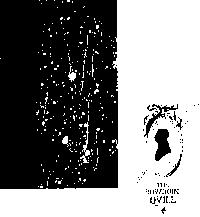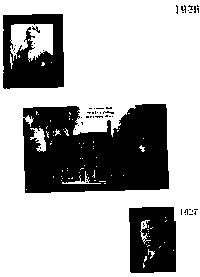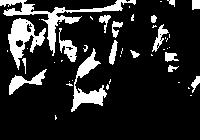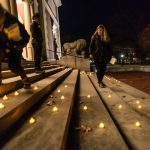In his latest column, on the cusp of Black History Month, John Cross ’76 reflects on two alumni from the 1920s who, “each in his own way, put a shoulder to the wheel to advance human dignity and ensure social justice.”
In looking through a bound copy of The Quill (Bowdoin’s literary magazine) for 1924 that had once belonged to President Kenneth C. M. Sills, Class of 1901, I came across a three-page essay on “Prejudices” by future Pulitzer Prize-winning journalist W. Hodding Carter, Jr., of the Class of 1927. After declaring that his initial impulse was to write a defense of the Ku Klux Klan, Carter proceeded to vent his anger at French Canadians, “Sons of Erin,” African Americans, and New Englanders whose ancestors had profited from the slave trade. By any standard, it was strong stuff to read in a College publication, especially coming, as it did, from a seventeen-year-old from Louisiana. It was with deep regret and no small measure of shame that Carter would later recall that for his first year at Bowdoin he refused to talk to (or even remain in the same room with) the College’s only African-American student at that time, who lived in an adjacent room in Winthrop Hall.
Carter’s attitudes and actions were not met with indifference on campus. Mary Ham (the wife of Professor of German Roscoe Ham) encouraged literary creativity by Bowdoin students at meetings in her home, and offered her assessment of Carter’s essay in a Bowdoin Orient review: “(It) is delightful in style, outrageous in spirit. Let us hope the style is the man.” Carter encountered students who challenged his assumptions and opinions, and faculty and administrators who understood that first-year students had a great deal to learn about the people with whom they would share life’s journey. Years later, Carter attributed a transformation in his attitudes on race relations to the gentle, but persistent, efforts of the Bowdoin community: “”¦looking back on those four years, I am convinced that the most important gift I received from Bowdoin was not what I learned here, but what I unlearned here.” When Carter returned to Louisiana after his graduation, he held new convictions about social justice that, in his own words, “rendered me more than a little suspect” in the deep South of the late 1920s.
- First paragraph of article on “Prejudices†by W. Hodding Carter, Jr. ’27, H’47.
- Worlds apart in adjacent rooms…
- Hodding Carter at a reception at the Alpha Delta Phi House, 1963, following the presentation of the Bowdoin Prize to him in 1963. His wife, Betty W. Carter H’79, is standing behind him.
Hodding Carter and his wife, Betty, established a newspaper in his home town of Hammond, and his editorials quickly established him at the top of Louisiana Governor Huey Long’s list of enemies. In 1936 he and Betty founded The Delta Star newspaper in Greenville, Mississippi, and together they took on the issue of deep-seated racism in the Depression-era South. Never one to adjust his editorial opinions to curry favor, Carter used to say that “We are so busy trying to make friends that we don’t take time to make the right kind of enemies.” World War II took Carter to the Middle East and North Africa as a journalist, where he witnessed first-hand the consequences of prejudices and poverty. In 1946 he received a Pulitzer Prize for an editorial on the discrimination faced by Japanese-American servicemen of the Nisei 442nd Regimental Combat Team returning to civilian life. Bowdoin awarded him an honorary degree in 1947.
Throughout the 1950s and ’60s Carter continued to stir up controversy. His denunciation of white violence prompted death threats, he was burned in effigy, and he was censured by the Mississippi legislature for supporting President Kennedy’s decision to send federal troops to safeguard the integration of the University of Mississippi. For taking these and other principled editorial stands he received the Bowdoin Prize in 1963. To current sensibilities his writings may seem paternalistic. Historians have pointed out that Carter took pride in what he saw as the best elements of Southern society, and that his views on integration were nuanced in ways that defy easy characterization here, but that kept him out of the mainstream of the civil rights movement.
“¦looking back on those four years, I am convinced that the most important gift I received from Bowdoin was not what I learned here, but what I unlearned here.
By all accounts, the story of Hodding Carter’s transformation at Bowdoin is compelling, and the story of his career is inspirational. But I also wondered what had happened to the single African-American student at Bowdoin who experienced the contempt of an unreconstructed Hodding Carter in 1923-24. Finding the identity of Henry Lincoln Johnson, Jr. ’27 (“Linc”) proved to be a great deal easier than finding out about his life after Bowdoin. Johnson grew up in Washington, DC, where his father ““ a lawyer active in Republican Party politics ““ had been appointed as Recorder of Deeds for the District of Columbia by President Taft. His mother was poet, playwright, and musician Georgia Douglas Johnson. Georgia held a regular literary salon in the Johnson home, which attracted the leading African-American intellectuals and artists of the day, including W. E. B. DuBois, Alice Dunbar Nelson, Langston Hughes, and Anne Spencer.
After his graduation in 1926, Linc earned a law degree from Howard University and opened a practice in Washington. He was active in the NAACP, and worked as an attorney for Congressman Adam Clayton Powell, Jr. of New York to advance the cause of civil rights. There are no letters from Henry in his alumni file, but there are several from his mother. In a 1963 letter she wrote, “He came [to Bowdoin] with a patch on the seat of his trousers and a little steamer trunk and I said: “˜Go my son and stay as long as you can'”¦While my son was there, he was allowed to help one of his teachers who was kind enough to allow him to help with his expenses “¦ he played the viola with his classmates and traveled with them for certain appearances. I believe those years at Bowdoin were among the pleasantest in his life. The atmosphere, the teacher and school-mates made school days delightful and unforgettable.”
Two young men, initially separated by Carter’s bigotry, would, each in his own way, put a shoulder to the wheel to advance human dignity and ensure social justice. Hodding Carter passed away in 1972 and Henry Lincoln Johnson, Jr. died in 1992. I wish that I could turn back time to seek answers that might fill in the gaps in the story created by Hodding’s bare bones account and by Henry’s unspoken words and unwritten lines about the 1923-24 year that they shared in Winthrop Hall.
With Best Wishes,

John R. Cross ’76
Secretary of Development and College Relations





Thanks for another great piece, and for your curiosity about Henry Lincoln Johnson, Jr. ’27. As usual, your curiosity is contagious. He was evidently quite a lawyer: his name shows up in at least two U.S. Supreme Court cases (Emanuel PEA Jr. v. UNITED STATES, 378 U.S. 571, 1964; COOK v. COOK, 342 U.S. 126, 1951), and he won both times. His name also shows up in many D.C. Circuit court opinions. Perhaps he was an appellate specialist?
I can see that Henry’s father’s reputation may have caused Henry to be a controversial figure in young Hodding Carter’s estimation; Henry’s father is characterized as a man of “significant influence and power … in Georgia and in national Republican politics” in Emancipation: The Making of the Black Lawyer, 1844-1944 by J. Clay Smith, Jr. and Thurgood Marshall, pps. 195-197.
John and Dave, two of my favorite history buffs!
Great column John, as always. Thanks for keeping the Bowdoin spirit alive.
John, this is one of your all-time best! I knew about Hodding Carter but nothing about Linc Johnson. Wish I had known so I could have included his story in my video history, To Serve the Common Good. Thanks, my friend!
And Barbara, I would have helped you film it! Carter & Johnson are fascinating in there juxtaposition. Nice work, John!
As I sit reading this in a Navajo clinic where we have one Navajo nurse, and no Native providers, I am reminded of Spring Break of ’76, when I visited my great aunt in rural SC. She was appalled that I was working with an African-American boss in the cafeteria, and admonished me that I should have come to the local college and studied chicken farming, instead of going to that damned Yankee school. I looked at her in horror–although I am not sure whether it was the prejudice or the chicken farming.
Later I learned that my mother had found it necessary to pull my father into the back bedroom for a lecture about appropriate behavior, when, in middle school, I had invited an African American classmate to dinner. Dad,however,had a profound interest in and respect for Native Americans. Since we lived in Montana,that was the minority group of my childhood. Hence those attitudes are what I had learned in regard to other cultures–and, thanks to Mom, didn’t learn otherwise. What I admire about Hodding Carter is his ability to “unlearn.” We need more of that in our world.
From his mother’s comments, Linc apparently found acceptance in spite of some “Hodding Carters,” some of whom were no doubt slower to “unlearn.” Carter, too, had found acceptance enough to sustain him when he returned home and found himself “suspect.” Perhaps that was the true gift to each man. I found “acceptance balanced with expectation” at Bowdoin and it had a profound effect on my life.
We do have an African-American doctor and PA, as well as a female doctor and PA. One of the Navajo CNAs’ son is in medical school, and the head of the lab is Navajo. We have come a long way, we still have a ways to go, and there is hope.
I was recently involved in an MLK Jr. memorial event, and have been trying to remember the name of his lieutenant who came with him on his visit to Bowdoin in the fall of ’63.
We had a few Russwurm scholars on campus, from MLK’s alma mater, Moorhouse College in Savannah.
After the speech in the First Parish Church, a group of us went back to the Moulton Union to gather in the lounge for a more intimate group. What happened that night was truly enlightening.
When one of the young men asked how long they had to suffer the villainies of the KKK and similar bigots, this mans told some horrifying experiences which had involved his friends. “But, ” he ended, “if we descend to violence, we are no better than they are.’
That night I fully understood the depths of non-violent protest.
If anyone can come up with the name of that one of MLK’s lieutenants I would appreciate it. I have told the story numerous times, but my training at Bowdoin and as a copy editor urge me to tell the story completely and accurately.
John,
So glad to read this history of Bowdoin. Your insights are always refreshing and sharp.
It’s always wonderful reading about Bowdoin alums like these guys who stood up for the common good. Hoping to see you during reunion weekend!
Best,
Dana
It is especially rewarding to read the comments of alumni, parents, and others, who enrich the The Whispering Pines columns with new information, insights, and personal experiences. Dave Larsson’s post adds important pieces to the story about father-and-son lawyers in the political world of Washington before and during the civil rights movement; Barbara Kaster’s documentary film about Bowdoin’s history underpins so much about what I know of the College’s history; Calanthe Wilson-Pant’s thoughtful commentary broadens, deepens, and personalizes issues of race and difference that we sometimes tuck away in memory or ignore; and David Henshaw highlights the event that brought Bayard Rustin (Deputy Director of the 1963 “March on Washington”) and Martin Luther King, Jr. to the campus for the Spring Issues Conference on May 5 and 6, 1964. The alumni magazine reported that after Rustin’s talk in Pickard Theater, he spoke with students in the Moulton Union from 9 P.M. to 3 A.M. Dr. King spoke the next night to an overflow crowd estimated at 1,100 at First Parish Church, which had a much greater seating capacity than Pickard Theater. The members of my family squeezed into seats scattered around the church, and were spellbound by the power and eloquence of Dr. King’s speech. Dan Levine (Bowdoin’s Thomas Brackett Reed Professor of History and Political Science Emeritus and one of the organizers of the event) has written a wonderful biography of Rustin, “Bayard Rustin and the Civil Rights Movement”, that was published by Rutgers University Press in 2000.
A little more than a decade ago, I met Professor Charles Marsh while he was teaching theology at Loyola College in Baltimore.(His family and mine were members of the Episcopal Cathedral of the Incarnation.) He had recently finished his award winning book, “God’s Long Summer: Stories of Faith and Civil Rights”. It chronicles the particularly violent and tense summer of 1964 in Mississippi.
Professor Marsh points out that Hodding Carter’s “Greenville Delta-Democratic Times” pointedly spoke out against Thomas and Robert Hederman – owners of two largest newspapers “Clarion Ledger” and “Jackson Daily News” — describing them as a homegrown product of Jim Crow racism and Christian fundamentalism. Marsh adds that Carter’s son, Hodding Carter,III, further described the Hedermans in his Princeton undergraduate thesis : “The Hedermans were to segregation what Joseph Goebbels was to Hitler.”
That Hodding Carter would attribute the forging of his progressive (and courageous) voice to his Bowdoin “education” is a remarkable component of the Civil Rights Movement.
Thanks John for a great story!